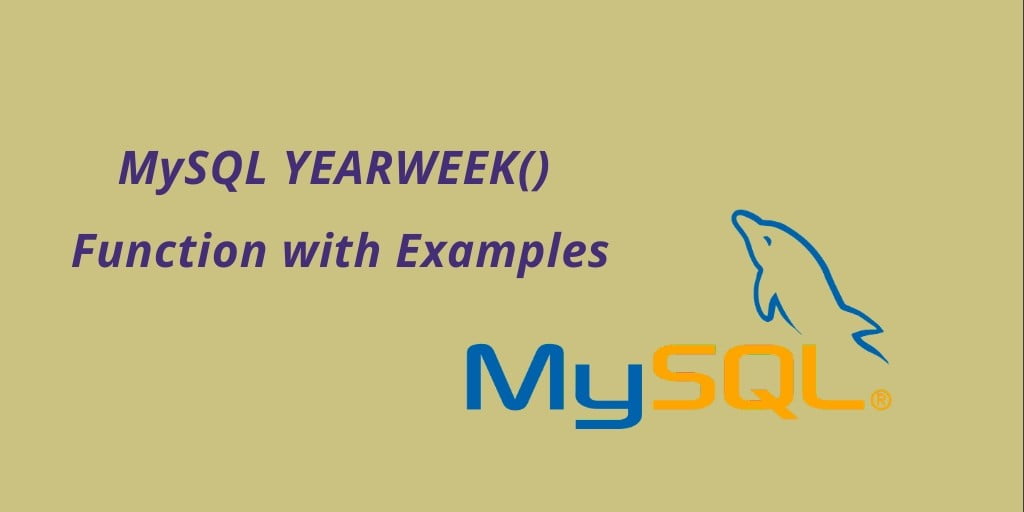MySQL YEARWEEK() Function; In this tutorial, we would love to share with you how to use of MySQL YEARWEEK() function with the help of examples.
MySQL YEARWEEK() Function
The MySQL YEARWEEK() function is used to returns the year and week for a given date. If you pass the date into the YEAR WEEK function, it will return the result.
You also have the option of specifying whether the week is to start on Sunday or Monday and should be in the range of 0 to 53 or 1 to 53, or not.
Syntax
Here is YEARWEEK() function syntax:
YEARWEEK(date) YEARWEEK(date,mode)
Where:
- The date is the date you want the number of weeks and weeks to come back from you.
- Mode is a number that specifies whether the week should start on Sunday or Monday, and weeks should be 53 or 1 to 53. See the table below for possible mode values.
If you do not specify the mode, the mode is 0.
Example-1
Now we take an example to demonstrate.
SELECT YEARWEEK('2025-01-02') As 'Result';
Output-1
+--------+ | Result | +--------+ | 202452 | +--------+
Example-2
Next, we take different date example.
SELECT YEARWEEK('1975-10-15') As 'Result';
Result:
+--------+ | Result | +--------+ | 197541 | +--------+
Example-3
However, you also have the option to present a second argument that you use the mode.
SELECT YEARWEEK('2020-12-10', 5) AS 'Mode 5';
Result:
+--------+ | Mode 5 | +--------+ | 202049 | +--------+
Below we are providing the list of mode values.
| Mode | First day of week | Range | Week 1 is the first week … |
|---|---|---|---|
| 0 | Sunday | 0-53 | with a Sunday in this year |
| 1 | Monday | 0-53 | with 4 or more days this year |
| 2 | Sunday | 1-53 | with a Sunday in this year |
| 3 | Monday | 1-53 | with 4 or more days this year |
| 4 | Sunday | 0-53 | with 4 or more days this year |
| 5 | Monday | 0-53 | with a Monday in this year |
| 6 | Sunday | 1-53 | with 4 or more days this year |
| 7 | Monday | 1-53 | with a Monday in this year |
These are the same values that can be used with the WEEK () function.
Example-4
Let’s take another example , extracting part of the year and week from the current date and time (which is now returned using the () function).
SELECT NOW(), WEEK(NOW());
Output-4
+---------------------+--------------------+ | NOW() | YEARWEEK(NOW()) | +---------------------+--------------------+ | 2019-07-10 18:30:44 | 201927 | +---------------------+--------------------+
Example-5
Let’s take a another example of using CURDATE() function. Basically CURDATE() function returns only the date without time. Here it will return the year and week.
SELECT CURDATE(), YEARWEEK(CURDATE());
Output-5
+------------+-----------------------+ | CURDATE() | YEARWEEK(CURDATE()) | +------------+-----------------------+ | 2019-05-15 | 201927 | +------------+-----------------------+
Look More Examples
Let’s take some MySQL YEARWEEK function examples and find out how to use the YEARWEEK function in MySQL.
mysql> SELECT YEARWEEK('2014-01-01');
Result: 201352
mysql> SELECT YEARWEEK('2014-01-05');
Result: 201401
mysql> SELECT YEARWEEK('2014-01-12');
Result: 201402
mysql> SELECT YEARWEEK('2014-07-16');
Result: 201428
mysql> SELECT YEARWEEK('2014-12-31');
Result: 201452
mysql> SELECT YEARWEEK('2015-01-01');
Result: 201452
Conclusion
Here, You have learned how to use mysql MONTH() function with various examples.
Recommended MySQL Tutorials
If you have any questions or thoughts to share, use the comment form below to reach us.
